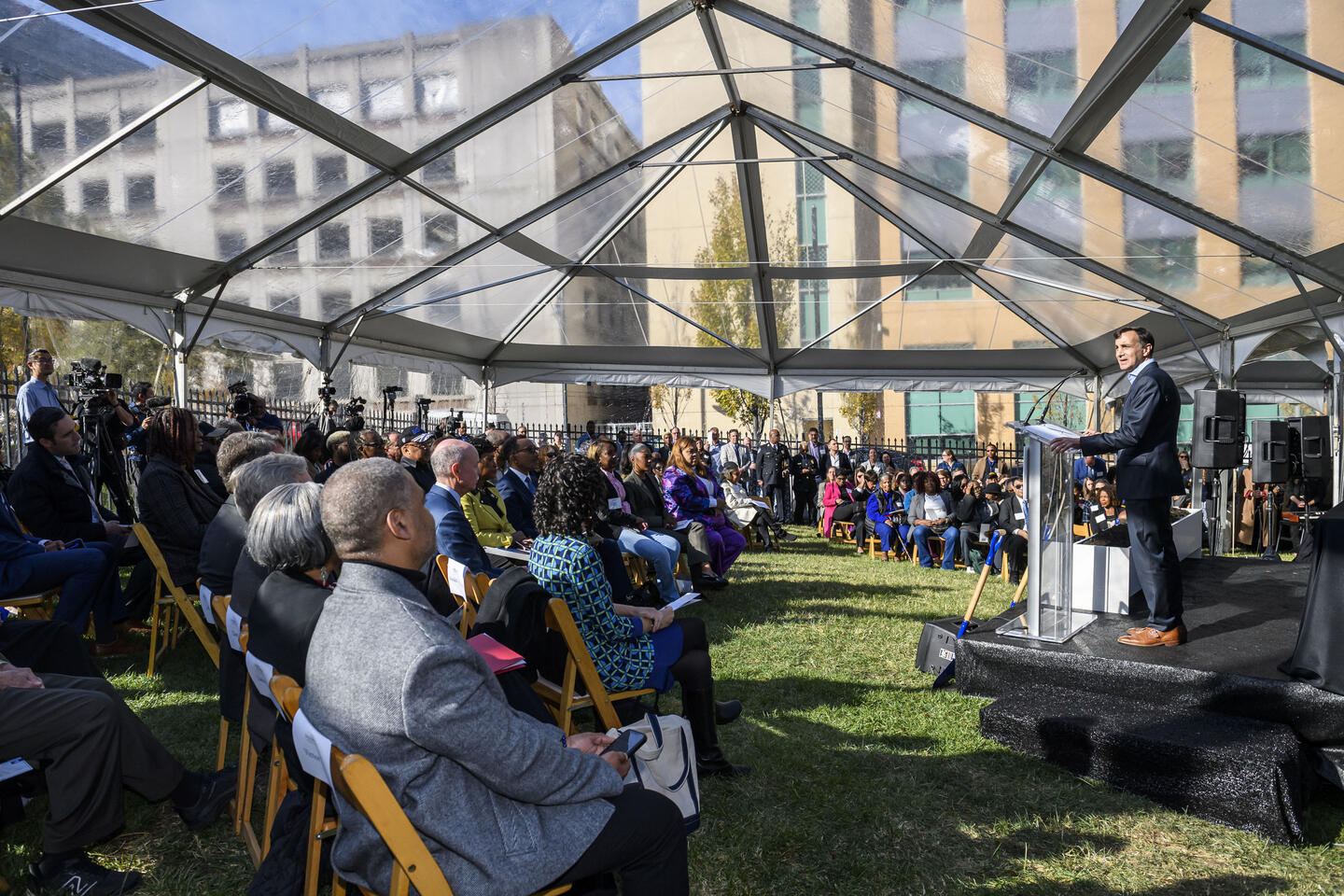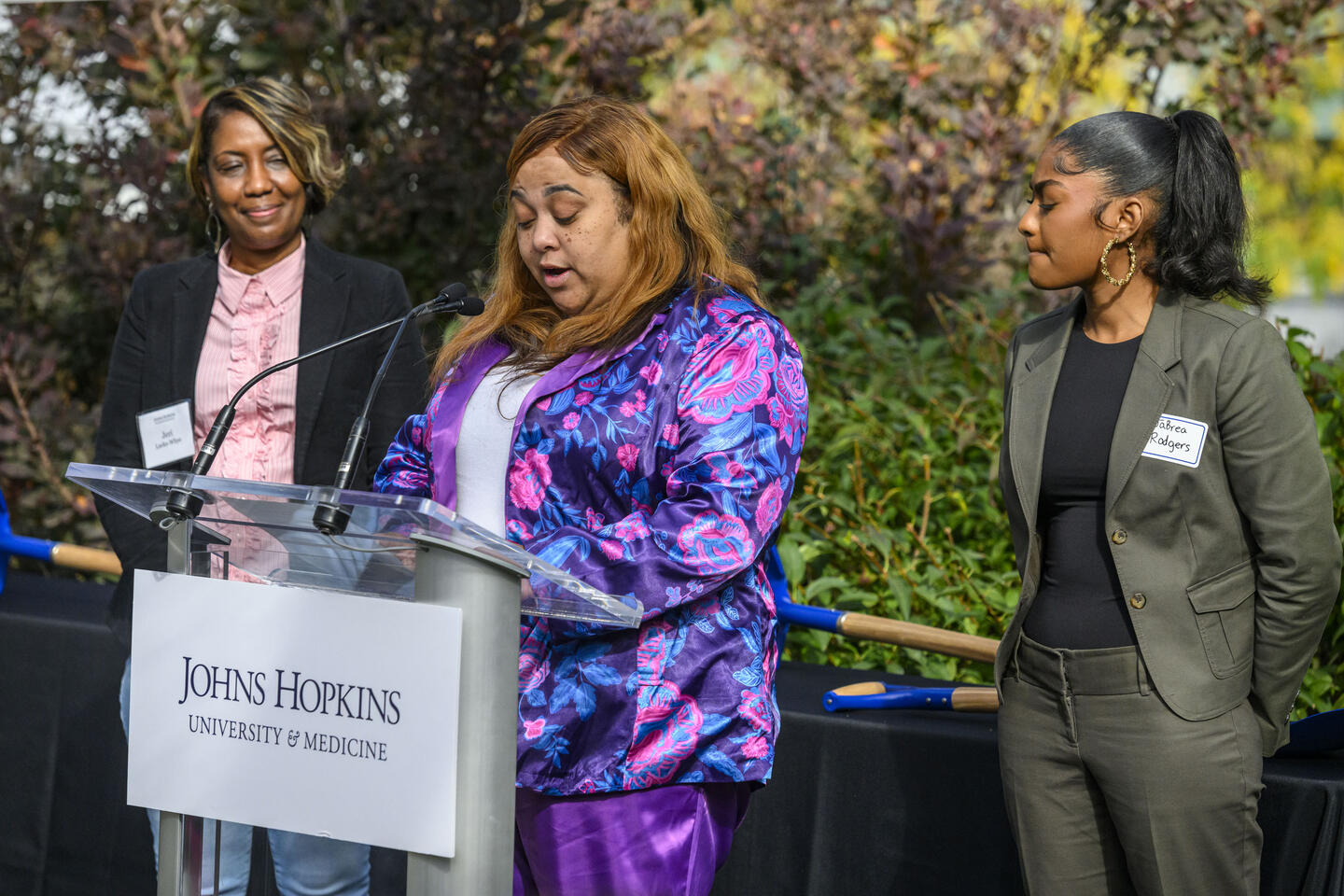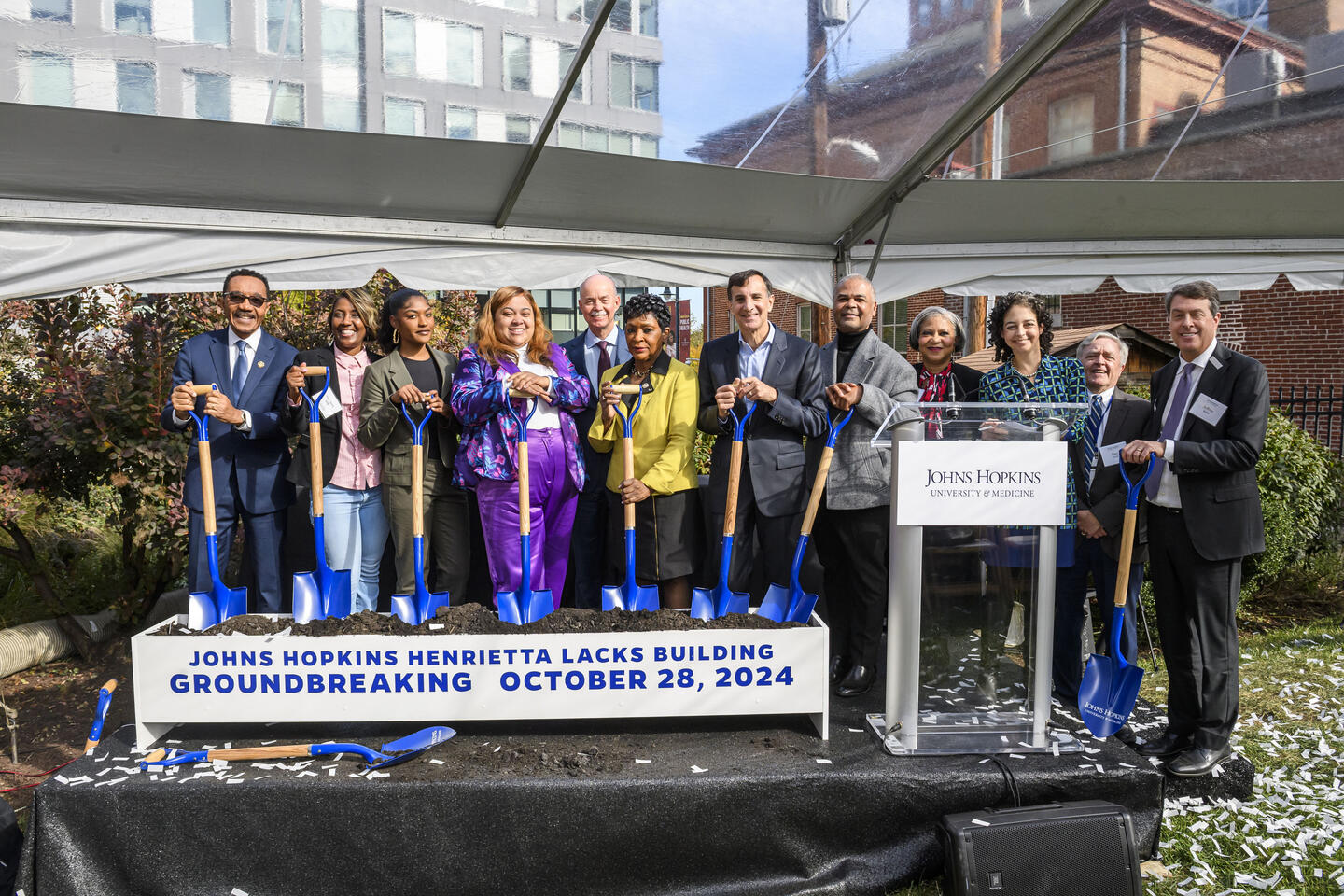Johns Hopkins breaks ground on building named in honor of Henrietta Lacks

Johns Hopkins University and Johns Hopkins Medicine, together with descendants of Henrietta Lacks, broke ground Monday on the future site of the building named in honor of Mrs. Lacks, the Baltimore County woman whose HeLa cells have contributed to medical advancements around the world.
The new 34,000-square-foot building will be located on the East Baltimore campus at the corner of Ashland and Rutland avenues and will adjoin Deering Hall, the historic home of the Berman Institute of Bioethics.
“Today we make a concrete commitment to ensure that Henrietta Lacks’ name will be as immortal as her cells,” JHU President Ron Daniels said. “When the Henrietta Lacks Building rises, it will be a vibrant, multidisciplinary site of learning, discovery, and dialogue that will facilitate community-oriented medical research and nurture the next wave of progress in the study and promotion of research ethics. We look forward to a building that will do justice to Henrietta Lacks’ transformative legacy, and we offer our heartfelt thanks to the members of the Lacks family for their generosity of spirit in lending this building her name.”

Image caption: Johns Hopkins University President Ron Daniels addresses attendees at the groundbreaking celebration.
Image credit: Will Kirk / Johns Hopkins University
The building will support multiple programs of the Berman Institute, Johns Hopkins University and the School of Medicine, and will house flexible program and classroom space for educational, research, and community use purposes.
“The success of the Berman Institute is built on opportunities for collaboration within our community and across the university,” said Jeffrey Kahn, director of the Berman Institute. “The breadth and depth of our work will expand with this new building, and its dedication to Henrietta Lacks is an important reminder of the need for ethics, equity, responsible science, and community-engaged research.”
Daniels and Kahn were among several speakers at the East Baltimore event, held beneath a tent on a crisp, sun-drenched fall morning. They were joined by university and community leaders, federal and local elected officials, and several descendants of Henrietta Lacks.
Lacks was a 31-year-old Black mother of five from Baltimore County who sought treatment at The Johns Hopkins Hospital in the early 1950s. Doctors diagnosed her with cervical cancer and, as medical records show, she received care that included the best medical treatment available at the time. Unfortunately, treatment was unsuccessful, and Lacks died in October 1951.
“Today is not about those immortal cells, as important as they are. Today is about immortalizing the name of the woman from whom those cells came.”
Theodore DeWeese
Dean of the medical faculty, CEO of Johns Hopkins Medicine
A sample of Lacks’ cancer cells was retrieved during a biopsy and sent to cancer researcher George Gey’s nearby tissue lab, where he had been collecting cells from patients who came to Johns Hopkins Hospital with cervical cancer. He discovered these cells were unlike any of the others he had seen: Where other cells would die, Lacks’ cells survived, and the number of cells would double every 20 to 24 hours. Soon after that, he began sharing the cells, at no cost, with researchers around the world.
Deemed “HeLa” cells, from the first two letters of her first and last name, the cell line that began from the biopsy from Lacks proved to be remarkably durable and prolific, and while many additional cell lines are in use today, HeLa cells have had a unique contribution to untold medical breakthroughs over the decades since their discovery—from vaccines for polio and COVID-19 to studies of the human genome to treatments for cancer and HIV/AIDS.
“Today is not about those immortal cells, as important as they are,” said Theodore DeWeese, dean of the medical faculty and CEO of Johns Hopkins Medicine. “Today is about immortalizing the name of the woman from whom those cells came. It is about ensuring that her name and her unknowing role will always be remembered by all of the students, by all the residents, by all the other trainees, by the faculty, the staff who walk into the building that’s going to rise on this plot of ground.
“She is without doubt one of the most important contributors to science and medicine, and it really is our hope that this building will serve as an important reflection on the meaning of her life to this world.”
Added Lisa Cooper, a Bloomberg Distinguished Professor at Johns Hopkins who founded and leads the Center for Health Equity and also directs the university’s Urban Health Institute: “There are many programs and people here at Hopkins who work every day to improve the health of communities in Baltimore and beyond through research, practice, and education. It is my fervent hope that the Henrietta Lacks Building will embody our ongoing commitment to health, equity, and social justice, a place where listening, relationship building, and collaboration will thrive. We know our journey is far from over, but our presence in this building will remind us of the progress we have made as we continue to strive for a more just and equitable future.”
In 2013, Johns Hopkins worked with members of the Lacks family and the National Institutes of Health to help craft an agreement that requires scientists to receive permission to use Henrietta Lacks’ genetic blueprint in NIH-funded research. The NIH committee tasked with overseeing the use of HeLa cells now includes two members of the Lacks family, including Jeri Lacks Whye, granddaughter of Henrietta Lacks, who was in attendance Monday.

Image caption: Lacks family members (from left) Jeri Lacks Whye, Veronica Robinson, and JaBrea Rodgers.
Image credit: Will Kirk / Johns Hopkins University
Other family members in attendance included JaBrea Rodgers and Veronica Robinson, both great granddaughters of Henrietta Lacks.
“I’m excited to break ground for the Henrietta Lacks Building,” Lacks Whye said in a statement. “Although this building will bear her name, it will also provide space for continued research, learning, and inspiring future generations. We acknowledge more than the scientific contributions made possible by her cells. We also acknowledge the story of a Black woman who did not live to see the world that her cells helped to create—a story that for too long was hidden. Our hope is that this building will continue to shed light on her legacy.”
Added Rodgers: “Today we recognize not just her cells, but her humanity. My great grandmother was a mother, a wife, and a friend. While we cannot change the injustices of the past, we can however ensure her legacy is known and celebrated. As we look to the future of this building, let it serve as a symbol not only of scientific advancements, but of the ongoing journey towards recognizing the humanity behind every discovery.”
Plans for the building were first announced in 2018, with initial designs shared in 2022. Vines Architecture is the design architect; Baltimore-based Design Collective is the architect of record; and local Baltimore construction firm Mahogany—in conjunction with Turner Construction Company—has led pre-construction services and will serve as the construction manager to deliver the building. Construction is expected to be complete in 2026.
Victor Vines, president of Vines Architecture, described the building’s features, including “a magnificent stair that ascends upward through the building toward the heavens, where I choose to believe Henrietta Lacks is today,” and a distinctive exterior that evokes the structure of DNA and is at once “veil-like” and “delicate,” yet also “strong, bold, and beautiful, which we believe is who this person was.”

Image caption: An architectural rendering of the new Henrietta Lacks Building, to be located at the corner of Ashland and Rutland avenues in East Baltimore.
Image credit: Vines Architecture
U.S. Rep. Kweisi Mfume, a Baltimore native who represents Maryland’s seventh congressional district in Congress, spoke about his long friendship with the Lacks family, dating to his childhood. He also noted his ongoing efforts to have Henrietta Lacks posthumously honored with a Congressional Gold Medal, the nation’s highest civilian honor.
“The Henrietta Lacks story is immortal, but for me it’s also personal,” he said. “Having seen and witnessed the struggle that it took all these many years to get attention on the cells and to bring attention back to Mrs. Lacks is a story in and of itself. … When I say this is a great and glorious day, I really, really do mean it.”
Added Adrienne Jones, speaker of Maryland’s House of Delegates: “All too often we see these stories forgotten by our history. The building we are breaking ground on today ensures that Henrietta’s story will continue to be told. It will stand as a testament to the spirit with which she lived her life. It will support programs that enhance partnership with the Baltimore community, and it will promote the study of research ethics.
“To Henrietta’s family, thank you for carrying her strength in your hearts,” she added. “We honor you with this building, and we honor Henrietta’s enduring legacy.”
To learn more about Henrietta Lacks and the wide-ranging impact of HeLa cells on medical research, visit the Henrietta Lacks page on the Johns Hopkins School of Medicine website. More information about the building project can be found at

Image caption: From left to right: U.S. Rep. Kweisi Mfume, Jeri Lacks Whye, JaBrea Rodgers, Veronica Robinson, School of Medicine Dean Theodore DeWeese, Maryland House Speaker Adrienne Jones, JHU President Ron Daniels, Victor Vines, Lisa Cooper, Lainie Rutkow, Dan Ford, and Jeffrey Kahn.
Image credit: Will Kirk / Johns Hopkins University
link






